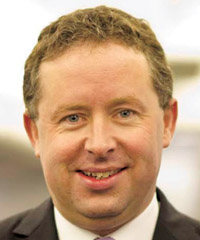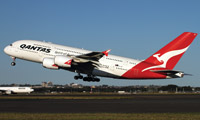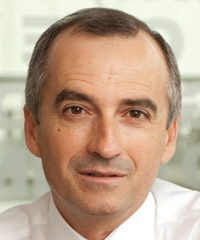Cover Story
Intensive care for Qantas
June 1st 2012
It’s been a grim couple of years for Qantas Airways and its going to get worse before it gets better. Indeed, there are those who question its very survival. A radical corporate restructuring currently underway could ultimately decide its fate, but the airline is facing massive hurdles to long-term viability. Read More »
 |
| Qantas chief executive, Alan Joyce: dismissed speculation about his future at the airline |
A major problem for Qantas’ chief executive, Alan Joyce, is that his flagship, long-haul Flying Kangaroo brand looks weather beaten. It lost $214 million in its last financial year. In the current 12 months, ending June 30, Joyce conceded the loss will be even higher, thanks to the controversial grounding of the fleet late last year, in a response to long-running industrial action, high fuel costs and increasing competition.
Joyce is moving quickly to heal the collective wounds and secure the future for Qantas International. But the benefits – if they come – won’t arrive overnight.
For example, he doesn’t expect the changes in international operations, which include upgrades to B747 interiors and reconfiguring of the A380 fleet to add more seats, to begin showing results until next year.
What is more, there is no guarantee the restructuring will work as Joyce and his team face enormous challenges. They include:
• International rivals into Australia on a steep growth curve. Gulf operators Emirates Airline, Etihad Airways and Qatar Airways, as well as China Southern Airlines are relentlessly adding capacity into Australia, making inroads into Qantas’ market share.
• Also internationally, local rival, Virgin Australia (formerly Virgin Blue), now linked with major offshore partners Singapore Airlines, Delta Airlines and Etihad Airways, is finally offering significant global network access to Qantas. For the first time, the lucrative corporate market has a genuine domestic and international option.
• Virgin, now transformed from no-frills to full-service, is also beginning to eat into Qantas dominance of the domestic market.
 |
| Qantas Airways: its Flying Kangaroo international brand has lost its bounce |
The latter development is particularly significant for Qantas. Its domestic operation made profits before tax of $552 million in the 2010-11 financial year.
Now, for the first time in years, its hold on the domestic market is under threat. Virgin chief executive, John Borghetti, who left Qantas after losing out on the CEO job to Joyce, has revitalized the carrier as a serious full-service competitor.
His forging of links with the international heavyweights and Air New Zealand, which is a 20% stakeholder in Virgin, and expansion of domestic operations, offers corporate travellers a viable alternative to Qantas, including an extensive international network.
The Qantas held view is a 65% domestic market share, with a high percentage of premium travellers, taking it to 80% revenue share. Today, it has slipped to about 63% market share.
Virgin had a modest 10% share of the corporate market, a position Borghetti wants to double within three years. What is worrying for Qantas is that he is well ahead of schedule. The latest figures, for February, put Virgin’s premium share at 17%. Its overall market share is 30% and edging higher.
Qantas also faces other issues. It is striving to rebuild customer confidence after a series of widely publicized events which impacted on its worldwide brand: the catastrophic engine explosion on an A380 offshore from Singapore in late 2010; cracks found within the wing structure of the global A380 fleet and the grounding of the fleet last year.
Another well publicized plan has fallen flat. Qantas has struggled to find a partner to float an Asian premium airline to take advantage of lower costs. Talks with Malaysia Airlines broke down in March. Joyce still wants to pursue the project, but it remains on the shelf.
Qantas’ interim results (ended December 31) and released in February, saw net income plunge 83% to $42 million.
 |
| Virgin Australia CEO and former Qantas executive, John Borghetti: revitalized the former Virgin Blue into a serious full-service competitor for Qantas |
The fleet grounding cost $194 million and fuel costs soared 26% to $2.2 million in the six months. Analysts slashed earnings forecasts for 2012, with Qantas unable to offer profit guidance for the full year due to the high degree of volatility and uncertainty in the market and “the major transformational change underway”.
As part of a five-year plan, the transformation will include, from next month, managing the airline as two distinct businesses – Qantas International and Qantas Domestic.
Each will have its own chief executive and operational and commercial functions. Their financial results will be reported separately. Simon Hickey, currently head of money-making Qantas Frequent Flyer and seen as a potential Joyce successor, will become chief executive of Qantas International while Lyell Strambi, group executive, Qantas airlines operations, will become head of the carrier’s domestic arm.
Joyce, who will remain chief executive of the Qantas Group, is also losing his Jetstar budget airline chief, Bruce Buchanan, at a critical time. The successful low-cost carrier (LCC) is in the midst of launching a joint venture in Japan with JAL, is working towards an LCC partnership, Jetstar Hong Kong, with China Eastern Airlines and is dealing with additional significant expansion around the Asia-Pacific.
“Qantas Domestic and Qantas International face very different situations. Qantas Domestic is strong and profitable. We are seeing the most sustained levels of high customer satisfaction on domestic services since 2004, and we are the airline of choice for corporate Australia,” said Joyce.
“Qantas International, a great airline with a rich history, is loss-making and does not deliver sustainable returns. However, we are committed to turning it around through the five-year strategy we announced last year, based on flying to global gateways, deeper alliances, smart investment in product and disciplined capital management.”
The good news for both carriers is that Australian domestic passenger numbers continue to rise. In March, the latest statistics available, Qantas group traffic rose 7% while Virgin saw a 6.7% increase in numbers. Additional capacity, however, meant Virgin load factors dropped some 4.5 percentage points to 76% while Qantas’ rose 3.3 points to 79.8%.
A day before announcing the corporate changes, Joyce disclosed that one of Qantas’ three maintenance bases, at Tullamarine airport in Melbourne, will close with the loss of 500 jobs. The closure will save the airline up to $100 million.
| The human cost In February, 2008, Qantas announced 1,500 staff cuts across the business. In April, 2009, it announced 500 management positions and 1,250 other staff were to go. In April, 2011, it announced another 200 management and support staff would go. In February this year, the airline announced 500 staff cuts across the board. In May, Qantas announced 500 engineers would be made redundant when it closed its Tullamarine maintenance base. Qantas said around 1,000 jobs will disappear in the next year or so, but unions have claimed these job losses will have a flow on effect into other areas and will ultimately result in the elimination of up to 6,500 jobs. Qantas has denied this forecast. |
For the time being maintenance will be consolidated at Brisbane and at Avalon, near Melbourne, but Joyce made it clear there would ultimately be only one base, likely to be Brisbane.
The introduction of new technology and modern aircraft means there will be a 60% reduction in heavy maintenance requirements in the next seven years.
Other steps Joyce has taken to reduce capital expenditure include:
* deferred delivery of the first of 50 B787 Dreamliners – early arrivals will go to Jetstar – for six months to mid-2013.
* early retirement of six older B747-400s.
* cancellation of Singapore-Mumbai and Auckland-Los Angeles services in May.
* postponement of two A380s, previously intended for delivery in early 2013, until 2016-17.
Capital expenditure in 2012-13 will be $1.9 billion compared with the $2.3 billion previously planned. “We are focused on making changes that will increase productivity and competitiveness in a range of areas, including modernizing and consolidating our catering operations, streamlining heavy maintenance and introducing new engineering processes,” said Joyce.
Consultant CAPA said Qantas needed to improve its links with international airlines, suggesting its alliance, oneworld, had “shaky linkages”. For example, oneworld member Cathay Pacific Airways “has almost zero cooperation with Qantas and has made clear it does not support the view of Qantas, and others, that oneworld needs a Chinese mainland member while Cathay’s ties to Air China become stronger”, it said.
It added that a tie-up between Qantas and Emirates Airlines might be “in the wind”, a possible development that has been strongly rumoured in recent months.
There is one other burning question emerging from Qantas’ trials and tribulations: how long can Joyce, who has become a highly controversial figure in Australia, survive at the helm?
Several analysts have suggested the management restructure is part of a succession plan in which the new divisional chief executives - Hickey, Strambi and Jayne Hrdlicka, who will succeed Buchanan at Jetstar, will have the opportunity to prove their worth as potential successors to Joyce.
He brushes that off. “I’m 46 and Geoff [Dixon, his predecessor as CEO] retired when he was 70. I’ve got a long way to go.” Ultimately, just how long that is may depend on how successful the current restructure turns out to be.